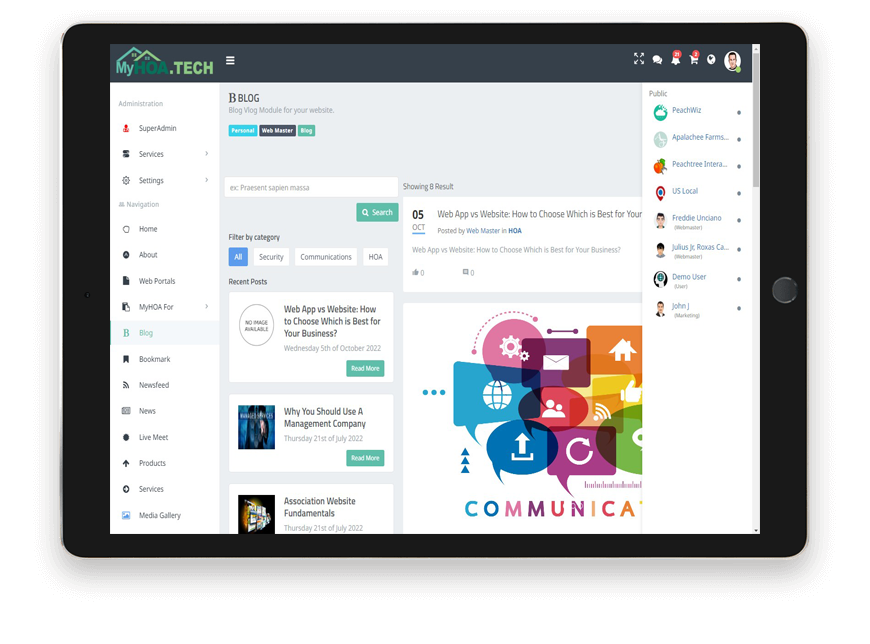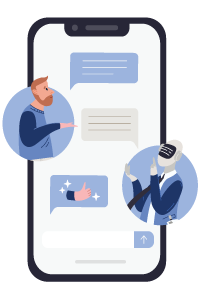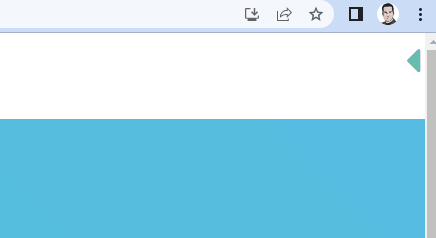A MyHOA web portal is an interactive gateway to what your community has to offer on the Internet. It is a single point of access designed to provide easy, fast access to applications, content, search, email, information, chat, media, and purchases.
MyHOA Web-Portals are delivered as SaaS
Software as a Service (or SaaS) is a way of delivering applications over the Internet as-a-service-subscription and made available as a website or a webapp.
Instead of installing and maintaining software, you simply access it via the Internet, freeing yourself from complex software development, upgrades, hardware maintenance, costs and management. Software as a service is a software licensing and delivery model in which software is licensed on a subscription basis and is centrally hosted. SaaS is also known as "on-demand software" and Web-based/Web-hosted software.
A MyHOA Web-Portal is a SaaS environment for providing Diverse Web Applications and Content Sources from a single user interface and presents users with the most relevant information for their context. A Web-Portal Platform is also described as a Social Portal System because of its user engagement capabilities when social modules are applied.
In a SaaS environment upgrades are automatic, and over time, simple web portals can evolve into portal systems that support complex digital customer experience initiatives.
The following are few of the characteristics of MyHOA Web-Portals:
Availability. MyHOA Web-Portal are available as a website or as a webapp and works for you 24hours, everyday.
Performance. MyHOA Web-Portals are optimized to Deliver Excellent Digital Experience For Your Critical Applications.
Scalability. MyHOA Web-Portals are built to handle growth, especially in handling more users and evolving concurrently with your needs.
Security. MyHOA Web-Portal security features prevent security vulnerabilities against threats such as unauthorized access and modification.
Functional. MyHOA Web-Portal modular application design insures thatmodules can be configured to provide any organization effective operational functionality.
Ease of use. MyHOA Web-Portals have ive characteristics of usability – effective, efficient, engaging, error tolerant, and easy to learn.
Content. MyHOA Web-Portal content can be accessible, interacted with, personalized, contextually adapted, and omni-accessible by specific roles.
Modern. MyHOA Web-Portals provide the ability to be responsive to a changing and emerging markets with quick delivery of products or services.
Optimized. MyHOA Web-Portals and application modules are constantly modified to make aspects of it work more efficiently or use fewer resources.
Responsive. MyHOA Web-Portals are designed to respond effectively to the behavior of the users, the environment, the size of the screen, orientation and platform.
Web-Portal can be provided as a website, wich means it a Web-Portal website cannot be installed on a device.
There are four kinds of Web-Portal Websites:
Web-Portal Static Website: Website consists of static HTML web pages only not dynamic.
Web-Portal CMS: Content Management System enablues admins to modify website pages and media.
Web-Portal Community Website: Where user profiles, management with user roles are applied to website.
Web-Portal Dynamic Website: Database driven Application Modules are applied depending on website needs such as Blogs, Events, Galleries, etc..
Web-Portal Social Website: Where social modules like newsfeed, groups, social follow, live chat are employed.
Web-Portal eCommerce Website: With methods of doing business on the website such as catalogs, shopping cart, marketplace, B2B.
Picking the sort of web-portal website configuration relies upon the kind of business and necessity of the enterprise. MyHOA offers every one of these kind of webortal sites and can evolve into a more complex Web-Portal site.
Web-Portal WebApps have the same characteristics described in SaaS and Website tabs, but unlike a Web-Portal Website, a Web-Portal WebApp can be installed on any device, wich means the user is always logged in, giving you close access to users via device notifications, and tools, like camera, phone, etc. no matter where they are with the device, but unlike native apps, it is not stored on the device locally on the device it is stored and hosted on remote servers.
A web application (WebApp) is application software that runs in a web browser, unlike software programs that run locally and natively on the operating system of the device. Web applications are delivered on the World Wide Web to users with an active network connection.
Web Apps can do more than just rendering content on the screen or connecting to web services. They can deal with files from the file system, they can interact with the system's clipboard, they can access hardware that is connected to the device, and much more.
When a Web-Portal WebApp is installed on a mobile device it can use the device features.
- Recieve real-time Notifications
- Send & Recieve SMS Messages
- Can use GPS
- Can upload files from a phone/tablet
- Can use the device’s gyroscope
- Can use the device’s accelerometer
- Can use swipe navigation
- Can use the device’s camera
- Can use the device’s compass
- Can access the device's list of contacts
- Other features may be accessible depending on the device
Two types of WebApps
Static web applications. Consists of static webpages, unsplash. This is the most basic type of web application and has little content or room for movement. Utilized for basic online presence and to provide static information.
Dynamic web applications. This style web app is more technically complex in comparison with the aforementioned static application because it include application modules that are dynamic in nature and developed for user interaction.
Web-Portal web applications have very high user experience. The web applications are available round-the-clock from anywhere in the world, and usable from any device for any screen size. Security for end users data, is flexible, and scalable to meet high demand. Additionally, it is rich user experiences built on the client. If you want users to have instantaneous access to your Web-Portal application modules and notifications, a Web-Portal WebApp is the way to go.
Native hybrid apps are installed through an application store (such as Google Play or Apple's App Store). They are developed specifically for one platform, and like webapps they can take full advantage of all the device features — they can use the camera, the GPS, the accelerometer, the compass, the list of contacts, and so on.
Web-Portal Native Hybrid App Features
Web-Portal Native Apps posses all of the Web-Portal SaaS, Web-Portal Website and Web-Portal WebApp characteristics and the features listed below.
- Optional fallback switch mode: Use local HTML folder if the user is offline, and use the remote URL if the user is online
- Native Loading Spinner/Android Activity Indicator while loading your URL
- Display a Splash Screen (e.g., containing animated GIFs) until the first page was loaded completely
- Smart Performance Cache Mechanism
- Offline Screen with “Try again” button if your app can’t connect to your URL
- HTML 5 Audio / HTML 5 Video Fullscreen / HTML Geolocation support
- URL Handling: Define which URLs should be opened in System Browser instead of your app (ideal for external links, e.g., Facebook/Twitter)
- Custom Status Bar Background Color
- HTML5 Live Audio Recording supported
- File Uploads & Camera Uploads supported
- Pull To Refresh Functionality
- In-App Purchases & In-App Subscriptions API (Extended License required)
- Custom User-Agent supported
- Option to prevent the device from going to sleep mode while the app is active
- Image, PDF, ePub, Documents, and Music File Downloader API (add unlimited file types that should trigger the built-in file downloader)
- Native Sharing Dialog API
- UUID API
- Take Screenshot API
- Social Login Support (“Login with Google” and “Login with Facebook”)
- Swiping Navigation Functionality
- “Reset the app” API (clear cookies and cache of your user via link)
- “Rate my app” Dialog
- Banner & Full-Screen Interstitial Ads by AdMob or Facebook Audience Network can be activated
- Push Notifications via JavaScript, Firebase, OneSignal, or bubble.io (with URL Deeplinking and Unique User Identification)
- Retrieve a UUID/Universally Unique Identifier via JavaScript easily
Web-Portal Native Apps
Convert your Web-Portal Website or Webapp into a native app for Android or IOS!
Try it! Download the MyHOA.Tech Native App and take a test drive.




